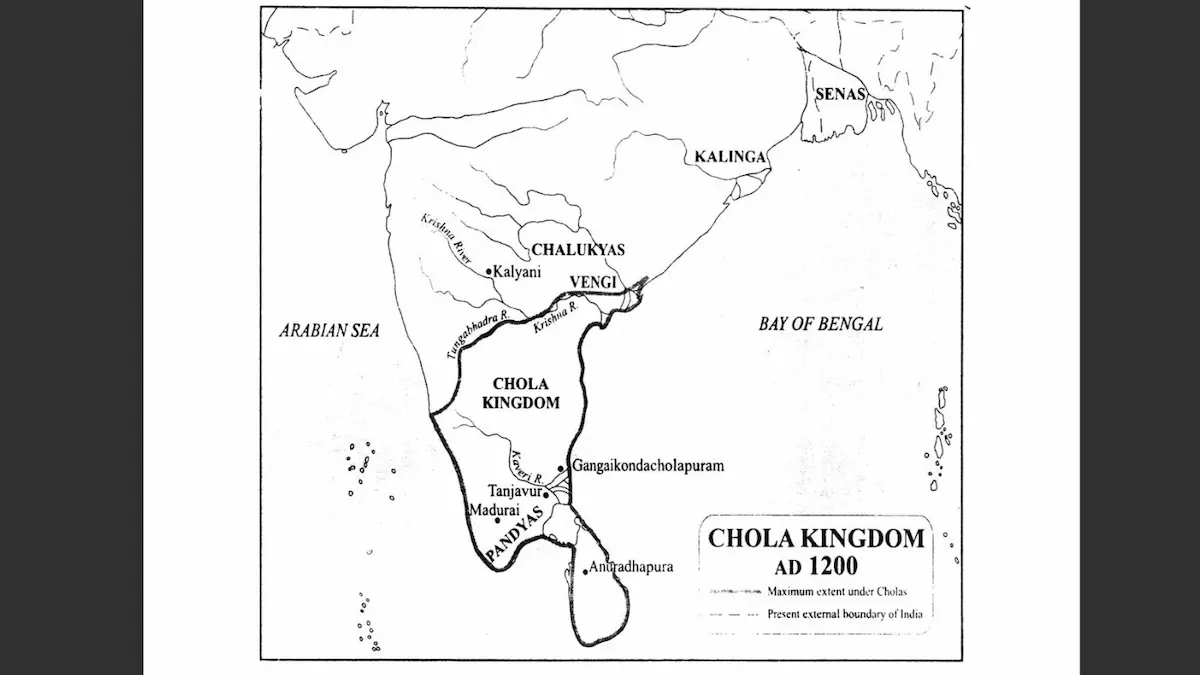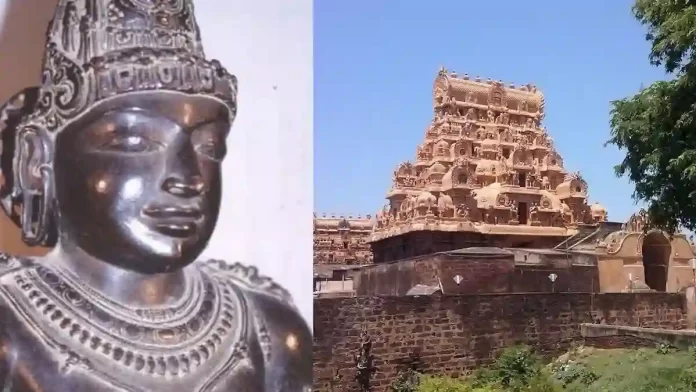The Chola dynasty was a powerful medieval ruling dynasty that ruled large parts of southern India between 700 AD and 1300 AD.
The dynasty is known for its daring naval and military expeditions against North India, Sri Lanka, Maldives, Malaysia, etc.
Read this to learn more about the Chola dynasty and empire.
Chola Dynasty Founder
The ancient Chola Dynasty dates back to the 3rd century BC. It was one of the longest-ruling dynasties in world history and is mentioned in the Ashokan Major Rock Edict No.13.
However, the Medieval Chola Empire was founded by Vijayalaya, a feudatory of the Pallavas.
In 850 AD, Vijayala captured Tanjore and laid the foundations of the Chola Empire.
And by the end of the ninth century, the Cholas had overrun southern India by defeating both the Pallavas of Kanchi (Tondaimandalam) and the Pandyas of Madurai.
Capital of Chola Dynasty
The cities of Tanjore, Gangaikondacholapuram, Kanchi, etc, served as capitals cities of the Chola Empire during different times.
Chola Dynasty Rulers
The two most significant and powerful rulers of the Chola dynasty are Rajaraja Chola and his son Rajendra Chola.
Rajaraja Chola
Rajaraja expanded the Chola frontiers through many conquests. His notable military expeditions include-
- Destruction of the Chera navy at Trivandrum
- Attack on Quilon.
- The capture of Madurai the Pandyan king.
- Invasion and annexation of Sri Lanka
- Conquest of the Maldives.
- Annexation of the northwestern parts of the Ganga kingdom in Karnataka
- Overrunning of Vengi.
Rajendra I
He succeeded his father Rajaraja in 1014 AD. He continued his father’s expansionist policies by undertaking the following military expeditions-
- Annexation of Pandya and Chera Empires
- Full conquest of Sri Lanka
- Invasion of Bengal
- Naval expeditions against the rulers of the Malay peninsula and Sumatra.
Chola Dynasty Map
At its height, the Chola dynasty ruled large areas of Southern India and the Deccan Plateau.

Significant Events
Following significant events took place during the rule of the Chola Dynasty.
Confrontations with Chalukyas
Cholas often clashed with “Later Chalukyas” of Kalyani for the overlordship of Vengi (Rayalaseema) and the fertile plains of Tungabhadra doab.
Invasion of Bengal
In 1022 AD, the Chola ruler Rajendra I invaded Bengal and Bihar by crossing the river Ganga. Besides, defeating Mahipala, the Pala ruler of Pataliputra, he also subdued many rulers on the way.
To commemorate this occasion, Rajendra I assumed the title of Gangaikondachola (the Chola who conquered the Ganga).
He also built a new capital near the mouth of the Kaveri river and called it Gangaikondacholapuram (the city of the Chola that conquered the Ganga).
Destruction of Kalyani
The Chola rulers sacked and plundered several Chalukyan cities including Kalyani and massacred their residents, including Brahmins. They did not even spare women and children.
They adopted a similar policy in the Pandya territories by settling military colonies to overawe the population.
Also Read| Gurjara Pratihara Dynasty: The Legendary Gujjar Empire
Conquest of Malaysia
Chola ruler Rajendra I undertook naval expeditions against the Buddhist rulers of the Sri Vijaya empire which extended over the Malay peninsula, Sumatra, Java, and the neighboring islands.
The expeditions led to the conquest of Kadaram or Kedah and a number of other places in the Malay peninsula and Sumatra.
There were commercial reasons behind this conquest. The Sri Vijaya Empire controlled the overseas trade route to China.
By conquering it, the Cholas wanted to expand trade with China by removing obstacles to Indian traders.
Invasion of Sri-Lanka
Cholas invaded Sri Lanka and destroyed the ancient city of Anuradhapura.
The Sri Lankan king and his queens were insulted and treated harshly by the Chola generals.
According to Satish Chandra, Sri Lanka was not able to free herself from Chola control for over 50 years.
Push for Local Self-Governance
The Cholas established a sound system of administration. In the villages all over the empire, they encouraged local self-government.
Chola Administration
Chola Empire was divided into four large provinces known as Mandalams.
The basic unit of administration was Nadu. Each Nadu consisted of a group of villages having close kinship ties.
These Nadus were further grouped into Valanadus.
Local Self Governance
Chola Empire is well known for its local self-governance.
An executive committee consisting of educated and properties persons managed the affairs of the village.
They were elected either by drawing lots or by rotation and had to retire every three years.
Numerous other committees helped in the assessment and collection of land revenue, for the maintenance of law and order, justice, etc.
The tank committee was an important committee that looked after the distribution of water to the fields.
However, the committees of Brahmin villages were more powerful. Mahasabha was a gathering of adult men in the Brahman villages.
It could distribute new lands, exercise ownership rights over them, and could also raise loans for the village, and levy taxes.
Units of Administration
| Nadus – a group of villages having close kinship ties |
| Valanadus – a group of Nadus |
| Mandalam – Provinces |
| Agraharams – tax-free Brahmin villages |
| Ur – a general assembly of a normal village |
| Sabha or Mahasabha – a gathering of the adult men in the Brahman villages |
Chola Dynasty Art and Culture
Like many kings and rulers of that age, the Chola dynasty also patronized art and culture.
They built great capital cities like Tanjore, Gangaikondacholapuram, Kanchi, etc, and decorated them with beautiful palaces and grand Hindu-Brahmanical temples.
They also gave shelter to Sanskrit scholars in their courts. Outside the royal courts, the local Tamil culture and literature also prospered during this time.
Famous Temples
The Chola Dynasty saw the establishment of large Hindu-Brahmin temples in South India.
These temples enjoyed revenue-free grants of lands for their expenses. Rulers and rich traders supported them with grants and rich donations.
Some of the temples became so rich that they entered the business, practiced usury, lent money, and took part in business enterprises, writes Satish Chandra.
In recent times, people have criticized Brahmanical temples for institutionalizing the unjust caste system, oppressing Dalits, and sexually exploiting poor women through the Devdasi system.
Quite recently, the Madras High Court quashed an FIR against an actor for criticizing the Chola Empire on similar lines.
Taking a bold and progressive stand in defense of the freedom of speech, the court held that when the voice of the oppressed is expressed by way of criticism, it should not be criminalized but should be heard and remedied.
That being said, the Dravida style of temple architecture attained its climax under the Chola Dynasty.
Some main features of these temples include-
- Vimanas or several stories
- Garbhagripha, the sanctum sanctorum of the main idol.
- Gopurams, which were lofty gates
- Mandaps or the pillared halls.
- A courtyard surrounded by high walls
Given below is a list of some famous temples from the Chola dynasty.
- Kailasanath Temple at Kanchipuram.
- Brihadiswara temple at Tanjore built by Rajaraja I.
- The Temple at Gangaikondacholapuram
Interestingly, Chola rulers who built such grandiloquent temples in their own cities didn’t hesitate to sack and burn temples of other kingdoms during their military expeditions.
Language and Literature
Sanskrit was the preferred language of the rulers, scholars, and court poets. However, literature in the local languages also witnessed some growth.
Nayanmars and Alvars
A Group of saints called Nayanmars and Alvars flourished between the sixth and the ninth centuries. While the former were devotees of Shiva, the latter were devotees of Vishnu.
Tirumurai
Tirumurai contains the writings of the Shaivite saints in eleven volumes. It is still considered sacred and looked upon as the fifth Veda.
Kamban
The acclaimed Tamil scholar Kamban is believed to have lived at the court of a Chola king in the early twelfth century.
The age of Kamban is regarded as a golden age in Tamil literature. Kamban’s Ramayana is considered a classic in Tamil literature.
The decline of the Chola Empire
The Chola Empire declined in the thirteenth century and was replaced by the Pandyas and the Hoysalas in the south.
The later Chalukyan Empire in Maharashtra also came to an end during the twelfth century and was replaced by the Yadavas and the Kakatiyas
Positive Sides
- They maintained political and commercial contact with foreign nations
- The Chola rulers sent a number of embassies to China between 1016 and 1033 AD.
- Maintained a strong navy. So much that the Bay of Bengal was converted into a ‘Chola lake’.
- The Chola rulers built a network of royal roads which were useful for trade as well as for the movement of the army.
- Trade and commerce flourished in the Chola empire, and there were some gigantic trade guilds that traded with Java and Sumatra.
- The Chola Empire gave farmers one of the highest positions in society.
Negative Sides
- During their attacks and invasions, they destroyed great ancient cities like Kalyani and Anuradhapura.
- Sometimes they massacred the residents of captured cities.
- They increased the grants to Brahmans and temples.
- During the plunder of Kalyani, they massacred Brahmins and didn’t even spare innocent children.
- Regressive taxation policies. Brahmin villages were not taxed.
- Sometimes girls from poor families were forced into the Devadasi system.
Primary Source
Satish Chandra, History of Medieval India.
